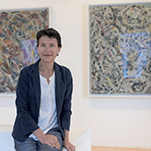Support from business and private parties is vitally important for culture
Interview with Karole Vail, the Director of the Peggy Guggenheim Collection in Venice.
Interview with Karole Vail, the director of the Peggy Guggenheim Collection in Venice.
Peggy Guggenheim bought Palazzo Venier dei Leoni along Canal Grande in Venice in 1949 to hold her collection. In 1976 she handedover ownership of the collection to the Solomon R. Guggenheim Foundation on the proviso that the works remained in Venice. After her death in 1979, the Foundation also took over the ownership of Palazzo Venier, Philip Rylands became its Director and converted the Collection into a museum proper. In 2017 Peggy Guggenheim’s granddaughter, Karole Vail, who studied art in the United Kingdom before working for the International Centre for Documentation on the Arts in Florence and the Solomon R. Guggenheim Museum in New York, took charge of the Collection.
You have been in charge since 2017. As Peggy Guggenheim’s granddaughter, did you feel any special responsibility when you took over?
Let’s say I feel doubly responsible: both from a professional viewpoint and also personally. I will certainly do my very best to fully respect the great legacy Peggy Guggenheim has left us and, at the same time, I will continue the work of a museum which, thanks to all its exhibitions and other events, is one of the best loved and most visited in Italy.
How would you sum up your two years in charge: overall assessment, problems you have encountered and your achievements? And what are the Collection’s future goals?
These first two years have been extremely intense and interesting. 2018 was my first full year in charge at the museum and I am proud to say that we put on three top-quality exhibitions for public, which were extremely well-received both by the critics and general public.
With the help of my assistants and partners, for the first time ever we have been able to organise a full and carefully planned schedule of Public Programs, which are free side events closely connected to our temporary exhibitions and have engaged both museum visitors and local people.
My plan is to maintain a high standard of exhibitions in the future and ensure close ties are maintained with the permanent collection and the artists it represents.
Being able to manage an important collection like this through a private foundation allows plenty of freedom in decision-making, as well as administrative-financial independence. Nevertheless, management cannot be easy with very little public funding. How do you deal with this problem and where does most of your income come from?
Most of our income comes from entrance ticket sales to the museum, as well as crucial support the Collection has been receiving for many years now from businesses and private parties. In this respect, Mapei has been a faithful fellow traveller for a long time, supporting the museum as a member of Guggenheim Intrapresæ and backing important projects aimed at developing the museum and protecting our artworks.
The cultural industry is growing in Italy, but it is still below European standards. Do you think we can turn this around and get more people to visit museums? Is it important for culture to be provided through a private foundation?
Most certainly! I firmly believe that culture provided by both public and private institutions that focuses on quality and research is the right way to get people more interested in culture.
Over the last few years, the Collection has been modernised, extended and redeveloped, work that the Mapei Group has also been involved in. Do you have plans for further work in the near future?
For the time being, no major work is scheduled, but the museum requires constant care and attention and so I cannot exclude further modernisation and maintenance work on existing structures being required in the near future.
During your first two years in charge, how much have you focused on partnerships and interaction with Venice’s other cultural institutions? More specifically, which institution have you worked with most or do you have most in common with as regards your aims and goals?
Before I took over, the museum had already developed excellent relations with other city cultural institutes, such as the university and other cultural-museum enterprises. I think Venice has plenty of high-quality culture to offer and is open to both the modern and contemporary, paying special attention to up-and-coming young artists.
Nowadays, it is hard to find a city in Italy that can offer everything from the mediaeval treasures of Palazzo Cini, the Renaissance art of the Gallerie dell’Accademia or Palazzo Ducale, the modern art in our Collection and Ca’ Pesaro’s, and the contemporary works of the Pinault Collection and Bienniale exhibitions.
We have developed excellent relations with all these enterprises so that we can offer a broad range of high-quality culture.
Peggy Guggenheim: is there anybody around today who makes art dealing and a love of art the very focus of their life the way she did?
This year, as the museum celebrates the 70th anniversary of when Peggy Guggenheim organised her first exhibition of contemporary sculpture at Palazzo Venier dei Leoni and also commemorates the 40th anniversary of her death in 1979, we are organising a schedule of Public Programmes entitled “The Continuity of a Vision”. Among these events and following in Peggy Guggenheim’s footsteps as a courageous art dealer unique of her kind, the Peggy Guggenheim Collection plans to hold a series of events throughout the year to which we will be welcoming a number of philanthropists and collectors, who, like Peggy Guggenheim, have made art their mission in society.







